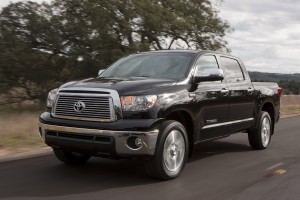Half-empty or half-full, Toyota’s performance in the U.S. market last month all depends on your point of view.
The maker reported what were unarguably its best sales numbers in five months during September, a 16.8% increase, prompting Group Vice President Bob Carter to proclaim, “Sales, in fact, were so strong during Labor Day, it felt like 2006 again.”
But after a year-long crisis that has undermined consumer confidence in the Toyota brand, the sales numbers for the current year indicate the Japanese auto giant has suffered some serious and potentially long-lasting damage.
While the sales improvement in September was certainly a bright spot, Toyota’s increase was notably smaller than those posted by several key competitors, including Ford Motor Co., Hyundai, Honda, Nissan and even Chrysler as the overall seasonally adjusted annual rate, or SAAR, for the U.S. market increased to 11.8 million units.
Strong sales of the RAV4 , 4Runner Highlander sport- utility vehicles, Sienna minivans, Prius hybrids and Tacoma pickup trucks gave Toyota a boost during September, the company said.
But the numbers through the first three quarters indicate Toyota has lost a significant amount of market share – a full 1.4 points, dropping from 16.6 %to 15.2% as the safety-related crisis has heated up.
(Toyota adding brake overrides to all ’11 models, even as it is sued over safety problems by insurer Allstate – Click Here for more.)
In addition, the loss in sales and market share is concentrated on the passenger car side of the business and involves traditional market leaders such as Corolla, which is off 2.3%, while sales of the midsize Camry are down 4.7% during the through the first three quarters of the year.
Sales of the Venza, one of the newest vehicles in the Toyota crossover line-up have dropped by more than 7%, and every vehicle in the Scion line has suffered a significant, double-digit decline in sales
this years. Overall, sales of Toyota passenger cars are down 5.9%, according to the company’s own sales figures, in the face of stiff competition from Hyundai/Kia, Nissan and Ford.
Another victim is the Toyota Prius, the world’s top-selling hybrid-electric vehicle. Its sales are also down 1%, so far this year, despite some heavy promotion by the company. But Prius is also suffering the same fate as other hybrids, which have seen demand plunge as fuel prices have held relatively low. New competition in the hybrid segment has only worsened the problem for Prius.
Ironically, like its American counterparts, Toyota now sells more SUVs and trucks than passenger cars.
Toyota executives noting that the compact Tacoma pickup now holds 45% of its segment and they expect to get more once Ford kills the Ranger. Carter said Toyota expects to increase production of the Tacoma at its truck plant in San Antonio, Texas, which originally was built to handle production of the full-sized Toyota Tundra.
That truck, however, has been a chronic underperformer since the introduction of the once-promising current generation. Tundra continues to trigger unfavorable reviews and word-of-mouth among truck owners who are clearly sticking with GM, Ford and Chrysler
Nonetheless, Tundra sales should benefit in the months to come from economic recovery. Tundra sales are up 21% this year but the total sales of the truck in 2010 could fall below 90,000 units, which is far short of Toyota’s original expectations.

